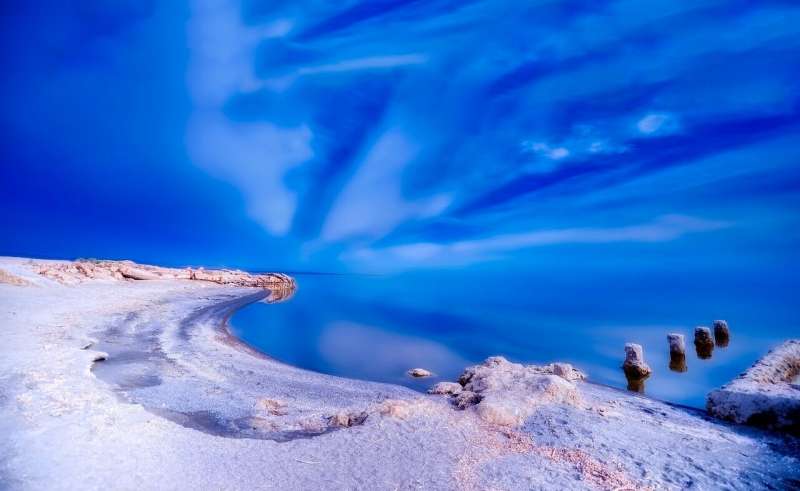Credit: CC0 Public Domain
California's largest internal body of water is steadily drying up, exposing a lake bed that threatens to trigger toxic dust storms and exacerbate already high levels of asthma and other respiratory diseases in Southern California.
Yet there is something about the Salton Sea that leads many lawmakers to ignore the urgency and put off remediation programs. It's just so far south—off the mental map of officials who represent more densely populated urban areas to the north, like Los Angeles. It is hydrologically unconnected to the Bay Area and the Sacramento-San Joaquin River Delta, which supplies water for so much of the state's agricultural and residential use. It is a disaster in the making, yet it is an afterthought.
That attitude is understandably galling to residents of the adjacent Imperial Valley, who are (for now) the ones most affected by the increasing dust and who have witnessed firsthand the degrading ecological conditions. They have heard officials promise repeatedly to fix this catastrophe by creating wetlands that moisten the exposed bed and sustain an ecosystem that continues to support migratory birds on the Pacific Flyway. They have repeatedly seen those promises broken.
The dimensions of the failure were for many years merely theoretical, but they became real in the winter just past. As the rain and snow washed away drought and at least temporarily diminished environmental problems in the rest of the state, the contraction of the Salton Sea accelerated. Increasing salinity kept the lake from sustaining even the salt-hardy tilapia. The birds failed to appear.
Until recently, lake levels had been sustained by Colorado River water under a 2003 agreement between the Imperial Irrigation District and the San Diego County Water Authority. It was an innovative and responsible arrangement. San Diego would pay for projects (lining earthen canals, for example) to help the Imperial Valley use water more efficiently. The water no longer needed in the valley would be exported to San Diego for residential use. Without excess water flushing through valley farmland, however, the runoff that formerly fed the Salton Sea would taper off, so for 15 years the Imperial Irrigation District would use some of its river water to counter evaporation at the lake. That would buy enough time for the state to develop and fund plans for the wetlands and other measures to keep the dust from blowing.
Or at least, that was the theory. The 15-year program of supplying "mitigation water" to the lake ended a little more than a year ago, but the state has so far failed to meet its benchmarks for developing wetlands.
This month, as the California Water Resources Board met at the Salton Sea lakeshore to discuss the remediation program's progress, members had to acknowledge that there hasn't been any. None of the promised projects have been completed. The Newsom administration has vowed a new focus on the Salton Sea, and there is reason for hope—but the lake is shrinking rapidly and action must now be accelerated to prevent a public health and environmental disaster.
Meanwhile, the Imperial Irrigation District tried but failed to leverage its massive Colorado River water rights into federal funding for Salton Sea projects.
A 19-year drought in the Colorado River Basin has been drying up lakes farther upstream that are crucial to the Southern California water supply, including massive Lake Mead. To prevent the water there from dropping too low to operate Hoover Dam's hydroelectric generators, California and six other states entered into talks over a drought contingency agreement to cut back their use of river water. The Imperial Irrigation District is the largest holder of river water rights and held out in the hope of winning a $200-million federal commitment for the Salton Sea.
But the Metropolitan Water District of Southern California wanted to move things along and covered Imperial's portion, so the drought agreement is proceeding without any funding for the Salton Sea. The Imperial Irrigation District asked members of Congress this week to not allow the drought contingency plan to move forward unless the district is included, and to ensure that federal funding legislation provides money for the Salton Sea, but the district has lost much of its leverage.
That leaves a shrinking lake, lots of broken promises and a looming disaster. Both California and the feds have to do better than this—especially if they want to encourage agreements such as the one that makes Imperial Valley farmers more water-wise while keeping San Diego residents from deep rationing. The Salton Sea is not going away, even if it goes away. It can become a wetland and wildlife preserve, or it can become—if we let it—a health and ecological catastrophe.
©2019 Los Angeles Times
Distributed by Tribune Content Agency, LLC.




















